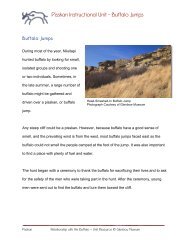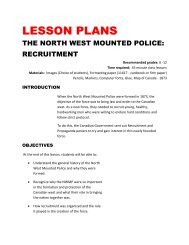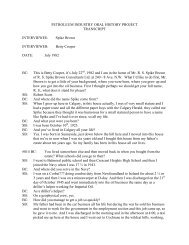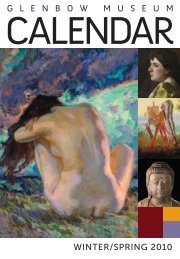Highlights - Glenbow Museum
Highlights - Glenbow Museum
Highlights - Glenbow Museum
Create successful ePaper yourself
Turn your PDF publications into a flip-book with our unique Google optimized e-Paper software.
CPR Oilwell, Dunmore,<br />
1910. <strong>Glenbow</strong><br />
Archives, NA-1072-11<br />
Shuham and Walker<br />
Stock Saddle, ca. 1870.<br />
<strong>Glenbow</strong> <strong>Museum</strong><br />
Miss Goldie St. Clair, world champion bucking<br />
horse rider, Calgary Exhibition & Stampede,<br />
Alberta, 1912. <strong>Glenbow</strong> Archives, NA-335-17<br />
Cowboys and ranching life are intrinsically tied to the<br />
history of Alberta. <strong>Glenbow</strong> <strong>Museum</strong> houses a range of<br />
ranching and rodeo artifacts that document the early<br />
days of ranching life.<br />
C. Rungius, Late Fall on<br />
the Clearwater (detail),<br />
oil on canvas, ca.1946<br />
56.11.2<br />
Eric Harvie at Meridian #1 well Ribstone<br />
area, Alberta, 1930. <strong>Glenbow</strong> Archives,<br />
NA-700-1<br />
Like Eric Harvie, Alberta experienced prosperity when<br />
oil was first discovered at Leduc in 1947, south of<br />
Edmonton. The oil and gas industry continues to<br />
dominate Alberta’s economy today and is well<br />
documented in <strong>Glenbow</strong>’s collections.<br />
Carl Rungius, wildlife artist, in his Banff<br />
studio, Banff, Alberta, 1947.<br />
<strong>Glenbow</strong> Archives, NA-5614-1<br />
<strong>Glenbow</strong> <strong>Museum</strong>’s art collection focuses primarily on<br />
northwestern North America; tracing the early story of<br />
Natives, early settlers and travellers as the West became<br />
more developed. Contemporary art has also been<br />
acquired to reflect the changing trends in art today.<br />
Immigrants to Canada<br />
on an Atlantic liner,<br />
ca.1913. <strong>Glenbow</strong><br />
Archives, NA-1687-37<br />
In collecting materials of settlement of Western Canada,<br />
Eric Harvie inevitably began tracing the growth of<br />
Alberta from its early development. <strong>Glenbow</strong> continues<br />
to be home to a range of fascinating objects brought<br />
to Canada by immigrant families. <strong>Glenbow</strong> also acts as<br />
a major research centre housing an extensive collection<br />
of unpublished materials ranging from the 1870s to<br />
the 1990s. Tracing the origins of immigrants has<br />
become a fascinating process for many descendents<br />
wanting to learn more about their families’ early<br />
pioneer experiences.<br />
F.A. Hopkins, Canoes<br />
in a Fog (detail), Lake<br />
Superior, oil on canvas,<br />
1869. 55.8.1<br />
First day of Ukrainian wedding celebrations,<br />
Vegreville, Alberta, 1970. <strong>Glenbow</strong><br />
Archives, NA-3386-14<br />
James Brady at Daly Lake, Saskatchewan,<br />
1953. <strong>Glenbow</strong> Archives, PA-2218-651<br />
The fur trade played an important role in the history<br />
of Western Canada, dominating the West’s economy,<br />
particularly in the North. The fur traders explored and<br />
mapped the unchartered territory and interacted with<br />
the Natives in their move west. The fur trade industry<br />
gave rise to the Métis, who became the backbone of<br />
the industry. <strong>Glenbow</strong>’s collections of documents,<br />
artifacts and art have proven to be vital for research<br />
and exhibitions.<br />
<strong>Glenbow</strong> <strong>Museum</strong> ANNUAL REPORT 2003/04 5








